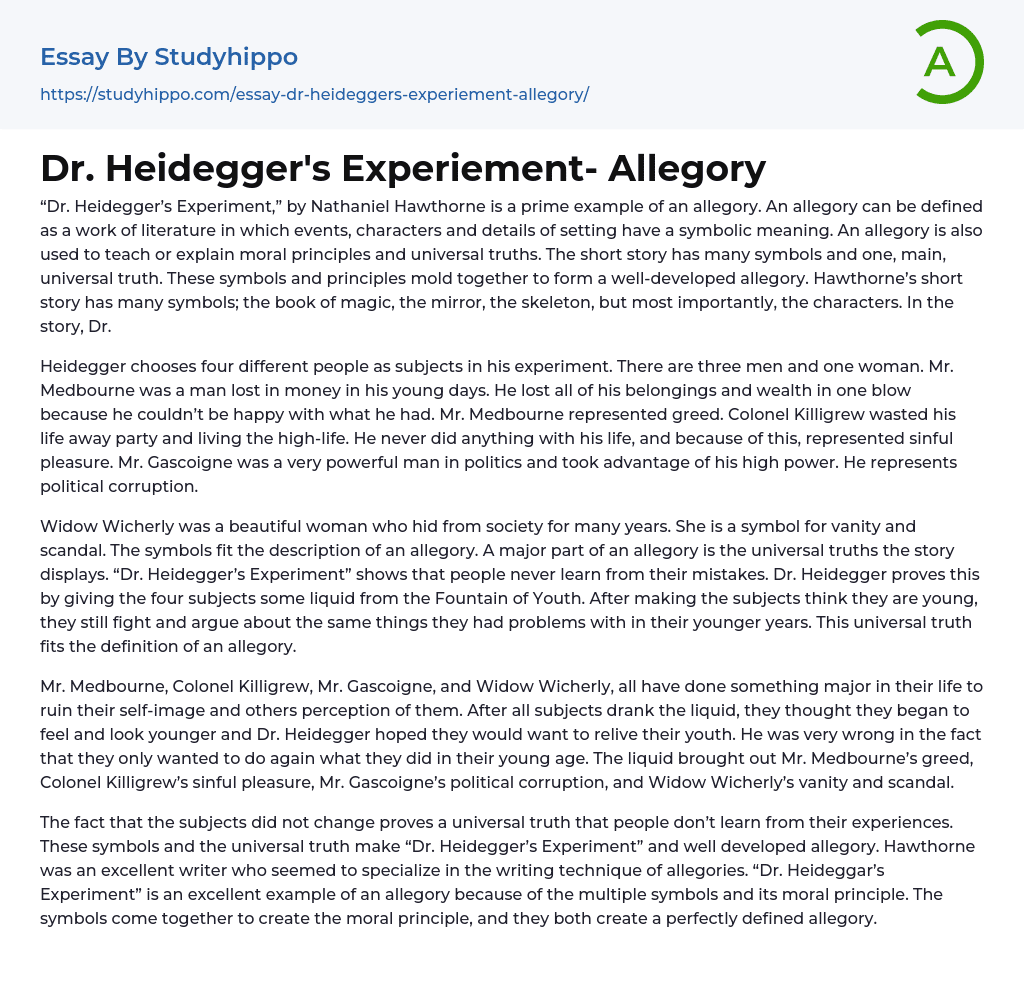“Dr. Heidegger’s Experiment,” by Nathaniel Hawthorne is a prime example of an allegory. An allegory can be defined as a work of literature in which events, characters and details of setting have a symbolic meaning. An allegory is also used to teach or explain moral principles and universal truths. The short story has many symbols and one, main, universal truth. These symbols and principles mold together to form a well-developed allegory. Hawthorne’s short story has many symbols; the book of magic, the mirror, the skeleton, but most importantly, the characters. In the story, Dr.
Heidegger chooses four different people as subjects in his experiment. There are three men and one woman. Mr. Medbourne was a man lost in money in his young days. He lost all of his belongings and wealth in one blo
...w because he couldn’t be happy with what he had. Mr. Medbourne represented greed. Colonel Killigrew wasted his life away party and living the high-life. He never did anything with his life, and because of this, represented sinful pleasure. Mr. Gascoigne was a very powerful man in politics and took advantage of his high power. He represents political corruption.
Widow Wicherly was a beautiful woman who hid from society for many years. She is a symbol for vanity and scandal. The symbols fit the description of an allegory. A major part of an allegory is the universal truths the story displays. “Dr. Heidegger’s Experiment” shows that people never learn from their mistakes. Dr. Heidegger proves this by giving the four subjects some liquid from the Fountain of Youth. After making the subjects think they are young, they still
fight and argue about the same things they had problems with in their younger years. This universal truth fits the definition of an allegory.
Mr. Medbourne, Colonel Killigrew, Mr. Gascoigne, and Widow Wicherly, all have done something major in their life to ruin their self-image and others perception of them. After all subjects drank the liquid, they thought they began to feel and look younger and Dr. Heidegger hoped they would want to relive their youth. He was very wrong in the fact that they only wanted to do again what they did in their young age. The liquid brought out Mr. Medbourne’s greed, Colonel Killigrew’s sinful pleasure, Mr. Gascoigne’s political corruption, and Widow Wicherly’s vanity and scandal.
The fact that the subjects did not change proves a universal truth that people don’t learn from their experiences. These symbols and the universal truth make “Dr. Heidegger’s Experiment” and well developed allegory. Hawthorne was an excellent writer who seemed to specialize in the writing technique of allegories. “Dr. Heideggar’s Experiment” is an excellent example of an allegory because of the multiple symbols and its moral principle. The symbols come together to create the moral principle, and they both create a perfectly defined allegory.
- Values of Life essays
- Ethical dilemma essays
- Normative Ethics essays
- Virtue Ethics essays
- Belief essays
- Deontology essays
- Moral essays
- Virtue essays
- Work Ethic essays
- Allegory essays
- Alliteration essays
- Comedy essays
- Comic book essays
- Drama essays
- Dystopia essays
- Fairy Tale essays
- Fantasy essays
- Fiction essays
- Ghost essays
- Gothic Fiction essays
- Gothic Literature essays
- Irony essays
- Legend essays
- Memoir essays
- Novel essays
- Poetry essays
- Satire essays
- Science Fiction essays
- Short Story essays
- The western essays
- Tragedy essays
- Witchcraft essays
- Acceptance essays
- Age Of Enlightenment essays
- Child Observation essays
- Confucianism essays
- Conscience essays
- Critical Reflection essays
- Destiny essays
- Determinism essays
- Empiricism essays
- Environmentalism essays
- Epistemology essays
- Ethics essays
- Ethos essays
- Existence essays
- Existentialism essays
- Fate essays
- Free Will essays
- Functionalism essays




